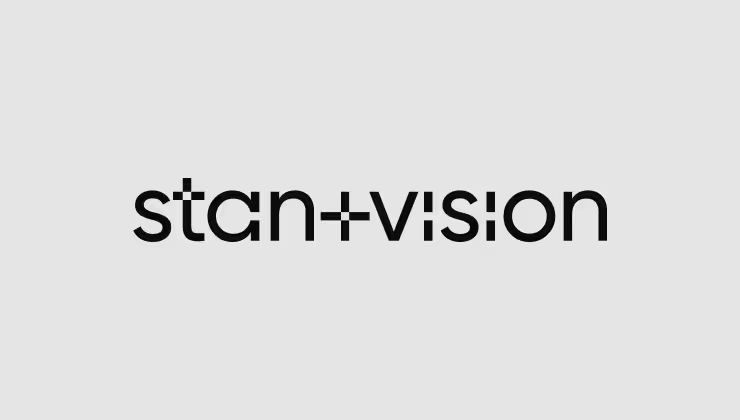Essential elements of a successful creative agency portfolio
A design agency’s design portfolio serves as its visual resume, presenting a snapshot of its capabilities, creativity, and professionalism in design. Several key elements of a digital portfolio must be meticulously crafted and thoughtfully presented to ensure it leaves a lasting impression on potential clients.

High-quality visuals
The adage “a picture is worth a thousand words” couldn’t be truer in the context of a graphic design portfolio. High-quality visuals are the cornerstone of captivating portfolio presentations, showcasing a wide range of graphic design skills, including logo design. Each image should be carefully curated to showcase the agency’s aesthetic sensibility, attention to detail, and technical expertise in graphic design. Including logo design in the portfolio demonstrates the agency's versatility and breadth of abilities, emphasizing its capacity to handle diverse graphic design projects.
Whether it’s sleek branding designs, captivating website layouts, or eye-catching illustrations, the visuals should not only demonstrate the agency’s creative prowess but also highlight its versatility and innovation across a spectrum of design projects. From vibrant color palettes to elegant typography, every element created should be thoughtfully composed to engage and inspire potential clients. A well-designed design portfolio website is crucial for presenting this work professionally online, showcasing the agency’s ability to create visually appealing and user-friendly portfolio websites.
Application portfolio management (APM)
Application Portfolio Management (APM) plays a pivotal role in the strategic vision of design agencies aiming to craft portfolios that captivate clients and drive sales. APM involves the meticulous curation and optimization of a diverse array of applications, tools, and projects within the agency's repertoire. Through APM, design agencies can ensure that their portfolio reflects a dynamic mix of their most innovative and impactful creations, showcasing their prowess across various mediums and industries. By strategically managing their application portfolio, agencies can effectively communicate their unique value proposition to potential clients, demonstrating their versatility, expertise, and commitment to excellence. This enables design agencies to attract new business and foster long-term relationships built on trust and mutual success.
Clear descriptions
While stunning visuals can grab attention, clear and concise descriptions provide essential context and insight into each project’s objectives, processes, and outcomes. These descriptions serve as the narrative thread guiding potential clients through the agency’s creative journey.
By articulating the project’s goals, challenges, and solutions succinctly, the agency demonstrates its strategic thinking, problem-solving abilities, and domain expertise. Whether it’s a case study a brand identity redesign, a website development project, or a packaging design endeavor, clear descriptions ensure that potential clients understand the agency’s approach and the value it brings to the table.
Testimonials
In an era dominated by social proof and peer recommendations, client feedback or testimonials play a crucial role in validating the agency’s capabilities and building trust with potential future clients. These testimonials serve as powerful endorsements of the agency’s work, attesting to its professionalism, reliability, and client satisfaction.

By featuring testimonials from satisfied clients, the agency not only adds a layer of credibility to its portfolio but also humanizes its brand, showcasing real-world examples of successful collaborations and positive outcomes. Whether it’s glowing praise for exceptional design work, commendation for outstanding communication, or recognition for meeting project deadlines, testimonials provide invaluable insight into the agency’s strengths and capabilities.
Contact information
Seamless communication is the lifeblood of any successful client-agency relationship. Therefore, it’s imperative that the portfolio prominently displays the agency’s contact information, making it easy for potential clients to reach out with inquiries or project opportunities. Whether it’s an email address, phone number, or contact form, the contact information should be readily accessible and strategically placed within the portfolio layout.

Additionally, incorporating calls to action and encouraging visitors to get in touch for a consultation or project discussion can further facilitate engagement and lead generation. By prioritizing seamless communication, the agency demonstrates its commitment to client satisfaction and lays the foundation for fruitful collaborations.
Showcasing services effectively
Effectively communicating the breadth and depth of services a business has offered is paramount to capturing the attention of potential clients and distinguishing oneself from competitors. Employing various strategies, including marketing outsourcing, can help design agencies showcase their services in a compelling and impactful manner. As a creative agency, we pride ourselves on offering a wide range of services, including web design, graphic design, digital marketing, and content creation, all designed to deliver impactful and visually stunning work supported by detailed analytics and effective visual presentations.
Organizing projects
One of the fundamental strategies for showcasing services effectively is to organize projects thoughtfully. By grouping projects based on service type or industry, design agencies can streamline navigation and ensure that visitors can quickly find relevant examples of the agency’s work. Showcasing graphic design skills through the thoughtful organization of projects can further highlight the agency's capabilities, demonstrating a range of competencies from traditional design to unique abilities like hand lettering.
Whether it’s branding and identity, web design, print collateral, a design project or UX/UI design, categorizing projects facilitates a seamless browsing experience, allowing potential clients to explore specific areas of interest and expertise.
Multimedia elements
Incorporating multimedia elements such as videos, animations, or interactive elements can significantly enhance the portfolio presentation and provide deeper insights into the agency’s work processes and achievements.
Videos can showcase design processes, from concept ideation to final execution, offering a behind-the-scenes look at the agency’s creative workflow. Animations can bring static designs to life, adding dynamism and interactivity to the portfolio. Interactive elements such as sliders, carousels, or clickable prototypes allow visitors to engage with the content actively, providing an immersive experience that goes beyond static images.
Highlighting unique selling points
To stand out in a crowded market, design agencies must identify and emphasize their unique selling points or areas of expertise. Whether it’s a particular design style, industry specialization, or innovative approach to product design, showcasing what sets the agency apart is crucial for capturing the attention of potential clients.

Design agencies can highlight their unique selling points through compelling storytelling, case studies, or dedicated sections in the portfolio. By effectively communicating the full package design agency’s strengths and differentiators, such as a focus on sustainability, expertise in user-centric design, or proficiency in emerging technologies, design agencies can make a memorable impression and attract clients who resonate with their values and offerings.
Best platforms for hosting design agency portfolios
In today’s digital age, choosing the right platform for a graphic design portfolio website is critical for showcasing the agency's work and attracting potential clients. This choice is paramount in highlighting the importance of a portfolio for a graphic designer, balancing personal vision with standout client samples. Design agencies have a plethora of options at their disposal, each offering unique features and benefits that can accentuate their digital agency portfolio’s unique animations, design aesthetics, color schemes, and minimalistic elements. Here are some of the best platforms for hosting design agency portfolios:
Dedicated portfolio websites
Platforms like Squarespace or Wix are popular choices for design agencies looking to create dedicated portfolio websites, including a design portfolio website. These platforms offer customizable templates specifically tailored for portfolio site presentation, allowing agencies to professionally showcase their design work online in a visually stunning and professional manner.
With user-friendly drag-and-drop editors, and robust features such as image galleries, sliders, and customizable layouts, Squarespace and Wix empower design agencies to create sleek and polished portfolios that reflect their brand identity and style. Additionally, built-in tools for SEO optimization and analytics provide valuable insights into website performance, helping agencies attract more visitors and track engagement metrics effectively.
Social media platforms
Social media platforms like Behance and Dribble serve as invaluable resources for design agencies seeking networking opportunities and exposure within the design community. With millions of active users, Behance and Dribbble provide design agencies with a global platform to showcase their work, connect with fellow creatives, and gain inspiration from industry trends and best practices.

By creating a profile and regularly sharing portfolio projects, design agencies can expand their reach, attract followers, and even collaborate with potential clients and collaborators. The interactive nature of these platforms encourages feedback and engagement, fostering a sense of community and facilitating professional growth and development.
Online design communities
For design agencies looking to target industry-specific audiences and gain targeted exposure to potential clients, online design communities such as Adobe Portfolio or Carbonmade offer tailored solutions. These platforms cater to the needs of creative professionals, providing specialized tools and features for portfolio presentation and promotion. With built-in portfolio builders, customizable themes, and integration with Adobe Creative Cloud applications, Adobe Portfolio empowers design agencies to create stunning portfolios that seamlessly showcase their work. Similarly, Carbonmade offers intuitive portfolio-building tools and a curated marketplace, allowing design agencies to connect with clients seeking creative services and projects.
By leveraging these online design communities' networking opportunities and industry-focused features, design agencies can effectively showcase their expertise, build their brand, and attract lucrative opportunities within their niche market.
Making portfolios stand out
To create a standout graphic design portfolio, it's crucial to follow specific graphic design portfolio tips that emphasize the importance of striking visual design and effective storytelling. Knowing what to include and how to present your work can significantly impact the portfolio's ability to capture attention and convey your creative vision. Steps to create the best portfolio include showcasing your most compelling work, using visual skills, integrating storytelling to share your journey and approach, and ensuring the portfolio is visually engaging with captivating imagery and bold design elements.

Striking designer portfolio design
Visual appeal is paramount in capturing the attention of visitors and making a memorable impression. By implementing visually appealing design elements such as captivating imagery, bold typography, and eye-catching colour schemes, design agencies can create a visually stunning portfolio that draws visitors in and encourages exploration. Intuitive navigation further enhances the browsing experience, allowing visitors to seamlessly navigate through the portfolio and discover the agency’s work with ease.
Incorporating storytelling
Beyond showcasing design projects, storytelling adds depth and personality to a portfolio, allowing design agencies to connect with visitors on a deeper level. By incorporating storytelling elements that highlight the agency’s journey, values, and approach to design, design agencies can create a compelling narrative that resonates with potential clients. Whether it’s sharing anecdotes about memorable projects, insights into the agency’s creative process, or showcasing the impact of design on clients’ businesses, storytelling adds a human touch to the portfolio and fosters a sense of authenticity and connection. Integrating creative ideas through storytelling can further demonstrate the agency’s ability to balance multiple tasks and take initiative, showcasing its unconventional and innovative nature.
Regular updates
Keeping the portfolio fresh and relevant is essential to demonstrate the agency’s ongoing creativity, innovation, and growth. By regularly updating content to showcase the latest work, including personal projects that highlight the designer’s versatility and creativity, design agencies can demonstrate their commitment to staying current and ahead of industry and design trends. Whether it’s featuring recent projects, highlighting new services or capabilities, or sharing insights and thought leadership content, regular updates ensure that the portfolio remains dynamic and engaging for visitors.
Stay up to date
Maintaining a balance between consistency and relevance is key when it comes to portfolio updates. While it’s important to keep the portfolio fresh and showcase the agency’s latest work, overwhelming visitors with constant changes can be counterproductive.

A quarterly update schedule strikes the right balance, allowing design agencies to refresh content, showcase new projects, and highlight recent achievements without overwhelming visitors or diluting the impact of the portfolio. This approach ensures that the portfolio remains current and relevant while providing a consistent and reliable browsing experience for visitors. Following design portfolio tips can help in maintaining a balance between consistency and relevance in portfolio updates.
Common portfolio mistakes and how to avoid them
Overloading portfolios
One common mistake design agencies make is overloading their portfolios with too many projects. Instead of quantity, focus on quality by including only the most relevant and impactful projects that best showcase the agency's expertise, creativity, and versatility. By curating a select portfolio of standout projects, design agencies can ensure that visitors are presented with the agency's best work and are not overwhelmed by unnecessary clutter or distractions.
Neglecting mobile responsiveness
With an increasing number of users accessing websites and portfolios on mobile devices, neglecting mobile responsiveness can be a costly mistake. Ensure that the landing page of the portfolio is optimized for mobile devices, with a responsive design that adapts seamlessly to different screen sizes and devices. This provides visitors with a consistent and user-friendly browsing experience, regardless of the device they are using, and ensures that the portfolio remains accessible and engaging for all users.
Failing to showcase the brand identity and design process
Another common mistake is failing to showcase the design process and problem-solving approach behind the agency's work. Providing insights into the agency's methodology, creative process, and problem-solving strategies adds depth and credibility to the portfolio, allowing potential clients to understand the agency's expertise and value proposition. Whether it's through case studies, project descriptions, or behind-the-scenes content, highlighting the design process provides visitors with valuable context and insight into the agency's capabilities and approach to design.
Importance of user experience (UX) in web design portfolios
In the realm of design agency portfolios, user experience (UX) holds paramount importance. A seamless and intuitive user experience is not only instrumental in keeping visitors engaged and interested but also plays a pivotal role in shaping their perception of the agency’s professionalism, attention to detail, and overall quality of work. The value that self-taught graphic designers bring to UX design cannot be overstated, as their unique perspectives and innovation potential enrich the design process, offering fresh and unconventional design solutions that enhance user engagement. The unique perspectives of self-taught designers can be particularly influential in this context, as they often bring innovative UX solutions to portfolio design, reflecting their distinct journeys and challenges in mastering design without formal education. Several factors contribute to a positive browsing experience, each of which is essential for creating a portfolio that captivates and resonates with visitors:
Fast loading times
In today's fast-paced digital landscape, where attention spans are increasingly limited, fast loading times are critical for retaining visitors and preventing them from abandoning the portfolio prematurely. Research has shown that even a one-second delay in page loading can lead to a significant increase in bounce rates. Therefore, optimizing portfolio performance and ensuring fast loading times is essential for providing visitors with a seamless and frustration-free browsing experience.

Intuitive navigation
Clear and intuitive navigation is the cornerstone of a user-friendly portfolio. Visitors should be able to easily navigate through the portfolio, find the information they are looking for, and discover projects that interest them without encountering any obstacles or confusion. Well-organized menus, logical page structures, and intuitive links are essential for guiding visitors through the portfolio and helping them explore the agency's work with ease. Explore the pros and cons of marketing outsourcing for your agency
Responsive design
With the proliferation of mobile devices and varying screen sizes, ensuring that the portfolio is accessible and functional across all devices is imperative. Responsive design allows the portfolio to adapt seamlessly to different screen sizes and resolutions, providing a consistent and user-friendly experience across desktops, laptops, tablets, and smartphones. By prioritizing responsive design, design agencies can ensure that their portfolio remains accessible to a wide range of users, regardless of the device they are using.
Integrating feedback into portfolio revisions
Integrating feedback into portfolio revisions is a critical aspect of portfolio management for design agencies. Feedback from clients and peers provides valuable insights into the strengths and weaknesses of the portfolio, helping design agencies refine their presentation, improve user experience, and ultimately, attract and convert potential clients more effectively. Here's how design agencies can effectively integrate feedback into portfolio revisions:
Soliciting feedback
Design agencies can solicit feedback from clients and peers through various channels, including surveys, direct communication, and collaborative discussions. Surveys can be designed to gather specific feedback on various aspects of the portfolio, such as design aesthetics, usability, content clarity, and overall impression. Direct communication with clients and peers allows for more in-depth discussions and exchanges of ideas, providing valuable qualitative insights into what is working well and what can be improved in the portfolio.
Analyzing user behavior and engagement metrics
In addition to soliciting feedback, design agencies can also analyze user behavior and engagement metrics to gain actionable insights into how visitors interact with the portfolio. Tools such as Google Analytics or heatmapping software can provide valuable data on metrics such as bounce rates, time on page, click-through rates, and navigation patterns. By analyzing these metrics, design agencies can identify areas of the portfolio that may be causing friction or confusion for users and prioritize revisions accordingly.
Identifying areas for enhancement
Once feedback has been collected and user behavior has been analyzed, design agencies can identify specific areas of the portfolio that require enhancement. This may include improving the visual design, optimizing navigation and usability, refining content messaging, or addressing any technical issues that may be affecting performance. By prioritizing revisions based on feedback and data-driven insights, design agencies can ensure that their portfolio evolves and improves over time better to meet the needs and expectations of their target audience.
Implementing revisions
After identifying areas for enhancement, design agencies can begin implementing revisions to the portfolio. This may involve updating visual elements, restructuring navigation menus, revising project descriptions, or optimizing page load times. Design agencies should approach revisions with a strategic mindset, focusing on making incremental improvements that align with the overall objectives of the portfolio and enhance the user experience for visitors.
Testing and iterating
Once revisions have been implemented, design agencies should test the updated portfolio to ensure that the changes have had the desired effect and address any issues that may arise. User testing, A/B testing, and usability testing can help validate the effectiveness of revisions and identify any additional areas for improvement. Based on testing results and ongoing feedback, design agencies can continue to iterate and refine the portfolio to ensure that it remains relevant, engaging, and effective in attracting and converting potential clients.
What I need in my visual designer portfolio?
Tailoring portfolios for different audiences is a strategic approach that allows design agencies to create personalized and impactful experiences that resonate with specific groups of potential clients, including individual designers.

By understanding the unique needs, preferences, and pain points of different target audiences, such as designers looking to showcase their portfolio examples of their work in a way that appeals to their unique style and achievements, design agencies can customize portfolio content and presentation to effectively engage and connect with potential clients. Here’s a closer look at how design agencies can tailor their portfolios for different audiences, including designers and design agencies with specific needs:
Understanding audience needs and preferences
The first step in tailoring portfolios for different audiences is gaining a deep understanding of their needs, preferences, and objectives. Design agencies should conduct thorough research to identify the industries, sectors, demographics, or personas they are targeting and gain insights into their specific challenges, goals, and pain points related to design services. By understanding what matters most to each audience segment, including designers who emphasize the importance of a sleek, professional portfolio to attract potential clients and decision-makers, design agencies can tailor their portfolio content and presentation to address their unique needs and preferences effectively.
Customizing portfolio content
Once audience needs and preferences have been identified, design agencies can customize portfolio content to resonate with each target audience. This may involve highlighting projects, case studies, and success stories that are most relevant and compelling to each audience segment. For example, design agencies targeting the healthcare industry may showcase projects related to medical branding, healthcare website design, or patient experience design, while those targeting startups may highlight projects that demonstrate agility, innovation, and rapid prototyping.
Adapting presentation style
In addition to customizing content, design agencies should also adapt the presentation style and messaging to align with the preferences and communication styles of each audience segment. For example, design agencies targeting corporate clients may adopt a more formal and professional tone, while those targeting creative agencies or startups may opt for a more casual and creative approach. By speaking the language of each audience segment and framing portfolio content in a way that resonates with their values and priorities, design agencies can establish rapport and credibility with potential clients.
Highlighting relevant expertise
Another key aspect of tailoring portfolios for different audiences is highlighting relevant expertise, skills, and capabilities that align with the needs and objectives of each audience segment. Design agencies should showcase projects that demonstrate their proficiency in areas that are most important to each audience, whether it’s branding and identity, web design, UX/UI design, or digital marketing. By highlighting relevant expertise and success stories, design agencies can position themselves as trusted partners who understand the unique challenges and opportunities facing each audience segment.
Personalizing outreach and engagement
Finally, design agencies should personalize their outreach and engagement efforts to connect with each audience segment on a deeper level. This may involve customizing marketing materials, email campaigns, and social media content to speak directly to the interests and pain points of each audience segment. By demonstrating empathy, understanding, and relevance in their communications, design agencies can build stronger connections and foster meaningful relationships with potential clients.
For designers, the importance of a portfolio cannot be overstated. It serves as a crucial tool for showcasing their unique style, talent, and achievements to potential clients and employers. It's essential for appealing to design agencies and their specific needs, proving design skills, and attracting new clients through SEO optimization.






